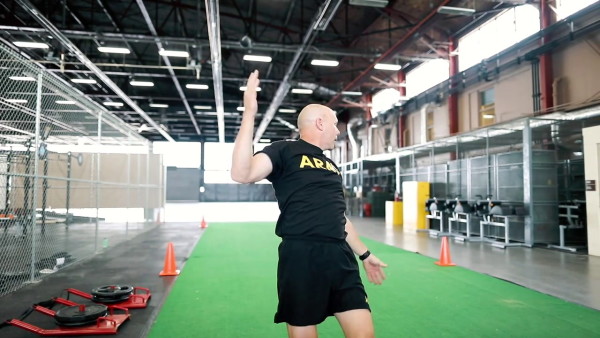

The Army is working on developing an alternate fitness test for soldiers with permanent injuries that prevent them from completing the new Army Combat Fitness Test.
The new test standards for permanent profiles won’t be finalized until October 2019, the Army said on Monday, but tests selected to be tested further include a 15,000 meter stationary bike ride, a 5,000 meter row, and a 1,2000 meter swim. Each event would be finished “in a set time, targeted at 25 minutes or less.”
Currently, the test’s events include the following:
- Three-repetition maximum deadlift
- Standing power throw
- Hand-release push-ups
- A 250-meter sprint-drag-carry
- Leg tuck
- A two-mile run
The alternate test would require the soldier to at a minimum complete the sprint-drag-carry, a 3-repetition maximum deadlift, and one of the aforementioned aerobic events. If the soldier’s condition did not prevent them from doing more than that, than they would. For example, an ankle injury would probably not prevent someone from doing the leg tuck.
A permanent profile, in the Army’s eyes, is essentially something that has been deemed unfixable: as Michael McGurk, director of research and analysis at the Center for Initial Military Training, told Task & Purpose, it’s something where “a year or more has passed and doctors have determined that the healing and retraining process is complete, and the condition is not going to get better.”
The most common injuries of this nature, he said, are things like a back or a knee injury. In that case, the profile typically says “run at own pace and distance,” which doesn’t mean the soldier can’t run, but just that they may be slower than others.
Sgt. Elvis Palarchie, Noncommissioned Officer of the Year for Bayne-Jones Army Community Hospital, Fort Polk, La., measures his stride during the 2-mile run, the last segment in the new Army Combat Fitness Test (ACFT)

(U.S. Army/Gloria Montgomery)
“And then someone says, ‘Well, how can they do the row or how can they do the bike if they can’t run?'” McGurk told Task & Purpose. “And I’m like, no, the profile is run at own pace and distance, which doesn’t mean that you can’t run, it means you may be…not as fast or as agile. But the test is designed that if you’re in a combat situation and you needed to perform these tasks, are you eligible? Are you capable of performing these tasks in a combat situation that would require you to do that?”
While things like hearing loss or bad eyesight are both permanent profiles, they aren’t being considered for the alternate assessment because they would not keep someone from completing the ACFT.
McGurk said in the press release that soldiers with permanent profiles “may also undergo a Medical Retention Board and Physical Evaluation Boards to determine fitness for further military duty. Part of those reviews may be tied to their ability to pass a modified assessment. This allows commanders to deploy these soldiers ‘with risk’ and determine if the risk is acceptable based on Soldier’s skills and nature of the mission.”
In other words, deploying a soldier ultimately lies with the commander no matter what the medical assessment of their condition might be. And as McGurk pointed out to Task & Purpose, just because a soldier is non-deployable doesn’t mean the Army couldn’t find another place for them to serve.
In the situation of a temporary profile — like a soldier twisting his or her ankle, for example — the soldier would wait until they were healed and cleared by the doctor before taking the regular ACFT. McGurk said the soldier would be given “the appropriate time to recondition and get into shape” before taking the test.
